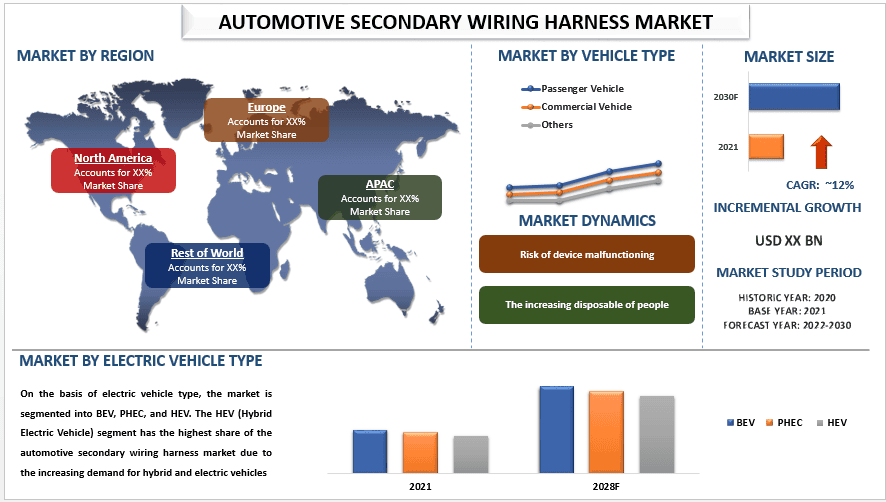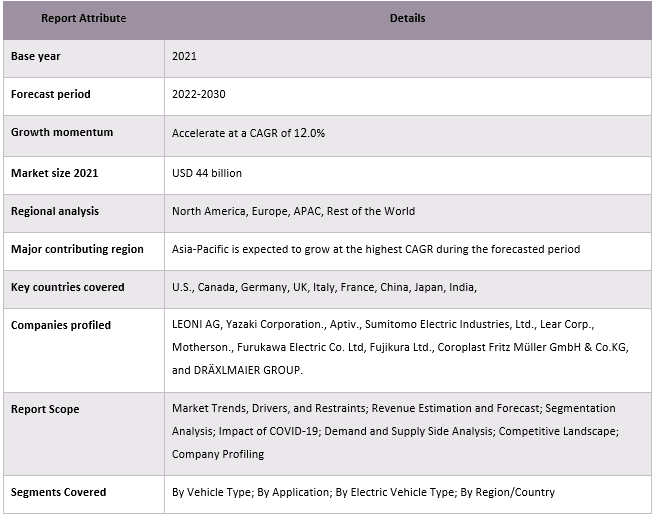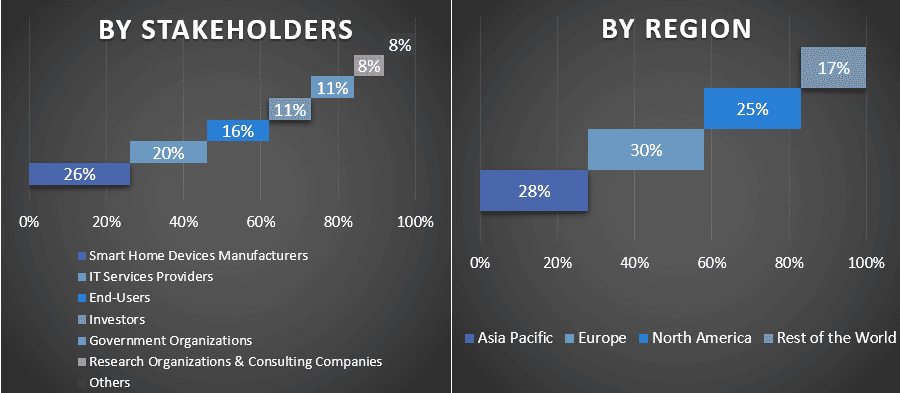- Home
- Chi siamo
- Settore
- Servizi
- Lettura
- Contattaci
Mercato dei cablaggi secondari automobilistici: analisi attuale e previsioni (2022-2028)
Enfasi sul tipo di veicolo (Veicolo passeggeri, Veicolo commerciale e Altri); Applicazione (Abitacolo, Cablaggio portiera, Cablaggio motore, Cablaggio airbag, Sistema di cambio marcia elettronico, Freni di stazionamento elettronici e Altri); Tipo di veicolo elettrico (BEV, PHEC e HEV); Regione/Paese

Il mercato dei cablaggi secondari per il settore automobilistico è stato valutato a 44 miliardi di dollari nel 2021 e si prevede che crescerà a un CAGR del 12,0% dal 2022 al 2028. La crescita dell'industria automobilistica in paesi come Cina, Giappone e India sta guidando la domanda di cablaggi secondari per il settore automobilistico nella regione. Il mercato dei cablaggi secondari per il settore automobilistico è altamente competitivo, con molti operatori attivi. Il mercato è caratterizzato dalla presenza di operatori sia globali che locali, ognuno con i propri punti di forza e di debolezza. In conclusione, si prevede che il mercato globale dei cablaggi secondari per il settore automobilistico crescerà a un ritmo moderato durante il periodo di previsione, trainato dalla crescente domanda di sistemi avanzati di assistenza alla guida, dall'elettrificazione dei veicoli e da severe normative relative alla sicurezza e alle emissioni dei veicoli. Il mercato è altamente competitivo, con molti operatori attivi. Ad esempio, nel giugno 2021, NGK Spark Plug Co. Ltd., un produttore leader di candele e cablaggi per l'industria automobilistica, ha annunciato di aver sviluppato un nuovo cablaggio ad alta tensione per veicoli elettrici. Il cablaggio è progettato per soddisfare le esigenze delle più recenti tecnologie dei veicoli elettrici, tra cui batterie ad alta tensione e sistemi avanzati di assistenza alla guida.
Alcuni dei principali operatori attivi sul mercato includono LEONI AG, Yazaki Corporation., Aptiv., Sumitomo Electric Industries, Ltd., Lear Corp., Motherson., Furukawa Electric Co. Ltd, Fujikura Ltd., Coroplast Fritz Müller GmbH & Co.KG e DRÄXLMAIER GROUP. Diverse fusioni e acquisizioni insieme a partnership sono state intraprese da questi operatori per facilitare i clienti con prodotti/tecnologie hi-tech e innovativi.
Approfondimenti presentati nel rapporto
"Tra i tipi di veicoli, si prevede che il segmento dei veicoli passeggeri avrà una crescita significativa"
Per tipo di veicolo, il mercato è segmentato in veicoli passeggeri, veicoli commerciali e altri. Tra questi, si prevede che il segmento dei veicoli passeggeri avrà una crescita significativa nel mercato dei cablaggi secondari per il settore automobilistico a causa della crescente domanda di sistemi avanzati di assistenza alla guida (ADAS) nei veicoli passeggeri, che sta guidando la crescita del mercato dei cablaggi secondari per il settore automobilistico. I sistemi ADAS richiedono molti sensori e cablaggi per funzionare correttamente, il che dovrebbe aumentare la domanda di cablaggi nei veicoli passeggeri. Inoltre, la crescente tendenza all'elettrificazione nei veicoli passeggeri sta anche guidando la crescita del mercato dei cablaggi secondari per il settore automobilistico. I veicoli elettrici richiedono cablaggi complessi per collegare i vari componenti elettrici, il che dovrebbe aumentare la domanda di cablaggi in questo segmento.
"Tra i tipi di veicoli elettrici, la tecnologia del mercato dei cablaggi secondari per autoveicoli wireless deteneva la quota di maggioranza del mercato nel 2021."
In base al tipo di veicolo elettrico, il mercato è segmentato in BEV, PHEC e HEV. Tra questi, si prevede che il segmento BEV (Battery Electric Vehicle) avrà una crescita significativa del mercato dei cablaggi secondari per il settore automobilistico a causa di diversi fattori. In primo luogo, la crescente adozione di BEV sta guidando la crescita del mercato dei cablaggi secondari per il settore automobilistico. I BEV richiedono molti cablaggi per collegare i vari componenti elettrici, come il motore elettrico, la batteria e i sistemi di controllo. Questo aumento della domanda di cablaggi dovrebbe guidare la crescita del mercato. In secondo luogo, la crescente tendenza all'elettrificazione nell'industria automobilistica sta anche guidando la crescita del mercato dei cablaggi secondari per il settore automobilistico. I BEV sono un componente chiave della tendenza all'elettrificazione e la crescente domanda di BEV dovrebbe guidare la domanda di cablaggi.
"Il Nord America avrà una crescita significativa nel prossimo periodo di previsione."
L'industria automobilistica in Nord America è una delle più grandi al mondo e un numero significativo di veicoli viene prodotto in questa regione. Questo elevato volume di produzione di veicoli guida la domanda di cablaggi e, quindi, il mercato dei cablaggi secondari per il settore automobilistico in Nord America. Inoltre, la regione ha una forte presenza di OEM automobilistici globali come General Motors, Ford e FCA, che sono i principali consumatori di cablaggi secondari per il settore automobilistico. La loro domanda di cablaggi guida il mercato. Inoltre, il Nord America ha una forte presenza di fornitori automobilistici che producono una gamma di componenti, inclusi i cablaggi, per l'industria automobilistica. Si prevede che la presenza di molti fornitori automobilistici nella regione guiderà la domanda di cablaggi secondari per il settore automobilistico. Infine, la regione ha una forte attenzione alla ricerca e sviluppo e vi è una forte enfasi sullo sviluppo di tecnologie avanzate come i veicoli elettrici e autonomi. Questa attenzione alle tecnologie avanzate dovrebbe guidare la domanda di cablaggi, che sono componenti essenziali nell'elettrificazione e nella guida autonoma dei veicoli. Nel complesso, la forte presenza dell'industria automobilistica, dei principali OEM automobilistici, di molti fornitori automobilistici e un'attenzione alla ricerca e sviluppo sono alcuni dei fattori chiave che guidano la crescita del mercato dei cablaggi secondari per il settore automobilistico in Nord America.
Copertura del rapporto sul mercato dei cablaggi secondari per il settore automobilistico

Motivi per acquistare questo rapporto:
- Lo studio include analisi di dimensionamento e previsione del mercato convalidate da esperti chiave del settore autenticati.
- Il rapporto presenta una rapida panoramica delle prestazioni complessive del settore a colpo d'occhio.
- Il rapporto copre un'analisi approfondita dei principali concorrenti del settore con un focus primario su dati finanziari aziendali chiave, portafogli di prodotti, strategie di espansione e sviluppi recenti.
- Esame dettagliato dei fattori trainanti, dei vincoli, delle tendenze chiave e delle opportunità prevalenti nel settore.
- Lo studio copre in modo completo il mercato attraverso diversi segmenti.
- Analisi approfondita a livello regionale del settore.
Opzioni di personalizzazione:
Il mercato globale dei cablaggi secondari per il settore automobilistico può essere ulteriormente personalizzato in base alle esigenze o a qualsiasi altro segmento di mercato. Oltre a questo, UMI comprende che potresti avere le tue esigenze aziendali, quindi sentiti libero di metterti in contatto con noi per ottenere un rapporto che si adatti completamente alle tue esigenze.
Indice
Metodologia di ricerca per l'analisi del mercato dei cablaggi secondari per autoveicoli (2022-2028)
L'analisi del mercato storico, la stima del mercato attuale e la previsione del mercato futuro del mercato globale dei cablaggi secondari per autoveicoli sono stati i tre passaggi principali intrapresi per creare e analizzare l'adozione del mercato dei cablaggi secondari per autoveicoli nelle principali regioni a livello globale. È stata condotta un'esauriente ricerca secondaria per raccogliere i dati storici del mercato e stimare le dimensioni attuali del mercato. In secondo luogo, per convalidare queste intuizioni, sono state prese in considerazione numerose scoperte e ipotesi. Inoltre, sono state condotte anche esaurienti interviste primarie con esperti del settore in tutta la catena del valore del mercato globale dei cablaggi secondari per autoveicoli. Postulando e convalidando i dati di mercato attraverso interviste primarie, abbiamo impiegato un approccio top-down/bottom-up per prevedere le dimensioni complessive del mercato. Successivamente, sono stati adottati metodi di suddivisione del mercato e di triangolazione dei dati per stimare e analizzare le dimensioni del mercato dei segmenti e dei sottosegmenti del settore di riferimento. La metodologia dettagliata è spiegata di seguito:
Analisi delle dimensioni del mercato storico
Fase 1: Studio approfondito delle fonti secondarie:
È stato condotto uno studio secondario dettagliato per ottenere le dimensioni del mercato storico del mercato dei cablaggi secondari per autoveicoli attraverso fonti interne all'azienda come relazioni annuali e bilanci, presentazioni sulla performance, comunicati stampa, ecc., e fonti esterne tra cui riviste, notizie e articoli, pubblicazioni governative, pubblicazioni della concorrenza, relazioni di settore, database di terze parti e altre pubblicazioni credibili.
Fase 2: Segmentazione del mercato:
Dopo aver ottenuto le dimensioni del mercato storico del mercato dei cablaggi secondari per autoveicoli, abbiamo condotto un'analisi secondaria dettagliata per raccogliere informazioni storiche sul mercato e quote per diversi segmenti e sottosegmenti per le principali regioni. I principali segmenti inclusi nel rapporto sono tipo di veicolo, applicazione e tipo di veicolo elettrico. Sono state condotte ulteriori analisi a livello di paese per valutare l'adozione complessiva dei modelli di test in quella regione.
Fase 3: Analisi dei fattori:
Dopo aver acquisito le dimensioni del mercato storico di diversi segmenti e sottosegmenti, abbiamo condotto un'analisi dei fattori dettagliata per stimare le dimensioni attuali del mercato dei cablaggi secondari per autoveicoli. Inoltre, abbiamo condotto un'analisi dei fattori utilizzando variabili dipendenti e indipendenti come prodotto, tecnologia e utenti finali del mercato dei cablaggi secondari per autoveicoli. È stata condotta un'analisi approfondita degli scenari di domanda e offerta considerando le principali partnership, fusioni e acquisizioni, espansioni aziendali e lanci di prodotti nel settore dei cablaggi secondari per autoveicoli settore di mercato in tutto il mondo.
Stima e previsione delle dimensioni attuali del mercato
Dimensionamento attuale del mercato: sulla base di informazioni utili derivanti dalle 3 fasi di cui sopra, siamo giunti alle dimensioni attuali del mercato, ai principali attori nel mercato globale dei cablaggi secondari per autoveicoli e alle quote di mercato dei segmenti. Tutte le ripartizioni percentuali richieste e le suddivisioni del mercato sono state determinate utilizzando l'approccio secondario sopra menzionato e sono state verificate attraverso interviste primarie.
Stima e previsione: per la stima e la previsione del mercato, sono stati assegnati pesi a diversi fattori, tra cui driver e tendenze, vincoli e opportunità disponibili per le parti interessate. Dopo aver analizzato questi fattori, sono state applicate le tecniche di previsione pertinenti, ovvero l'approccio top-down/bottom-up, per arrivare alla previsione di mercato per il 2030 per diversi segmenti e sottosegmenti nei principali mercati a livello globale. La metodologia di ricerca adottata per stimare le dimensioni del mercato comprende:
- Le dimensioni del mercato del settore, in termini di entrate (USD) e il tasso di adozione dei cablaggi secondari per autoveicoli nei principali mercati a livello nazionale
- Tutte le quote percentuali, le suddivisioni e le ripartizioni dei segmenti e sottosegmenti di mercato
- Attori chiave nel mercato globale dei cablaggi secondari per autoveicoli in termini di prodotti offerti. Inoltre, le strategie di crescita adottate da questi attori per competere nel mercato in rapida crescita.
Convalida delle dimensioni e della quota di mercato
Ricerca primaria: sono state condotte interviste approfondite con i Key Opinion Leader (KOL), inclusi i dirigenti di alto livello (CXO/VP, responsabile delle vendite, responsabile del marketing, responsabile operativo, responsabile regionale, responsabile nazionale, ecc.) nelle principali regioni. I risultati della ricerca primaria sono stati quindi riepilogati ed è stata eseguita un'analisi statistica per dimostrare l'ipotesi dichiarata. Gli input della ricerca primaria sono stati consolidati con i risultati secondari, trasformando così le informazioni in informazioni utili.
Ripartizione dei partecipanti primari nelle diverse regioni

Ingegneria del mercato
È stata impiegata la tecnica di triangolazione dei dati per completare la stima complessiva del mercato e per arrivare a numeri statistici precisi per ciascun segmento e sottosegmento del mercato globale dei cablaggi secondari per autoveicoli. I dati sono stati suddivisi in diversi segmenti e sottosegmenti dopo aver studiato vari parametri e tendenze nelle aree del prodotto, della tecnologia e degli utenti finali nel mercato globale dei cablaggi secondari per autoveicoli.
L'obiettivo principale dello studio sul mercato globale dei cablaggi secondari per autoveicoli
Le tendenze di mercato attuali e future del mercato globale dei cablaggi secondari per autoveicoli sono state individuate nello studio. Gli investitori possono ottenere informazioni strategiche per basare la loro discrezione per gli investimenti sull'analisi qualitativa e quantitativa eseguita nello studio. Le tendenze di mercato attuali e future hanno determinato l'attrattiva complessiva del mercato a livello regionale, fornendo una piattaforma per il partecipante industriale per sfruttare il mercato non sfruttato per beneficiare di un vantaggio di first-mover. Altri obiettivi quantitativi degli studi includono:
- Analizzare le dimensioni attuali e previste del mercato dei cablaggi secondari per autoveicoli in termini di valore (USD). Inoltre, analizzare le dimensioni attuali e previste del mercato di diversi segmenti e sottosegmenti.
- I segmenti nello studio includono le aree del tipo di veicolo, dell'applicazione e del tipo di veicolo elettrico.
- Definire e analizzare il quadro normativo per l'industria del mercato dei cablaggi secondari per autoveicoli
- Analizzare la catena del valore coinvolta con la presenza di vari intermediari, insieme all'analisi del comportamento dei clienti e dei concorrenti del settore.
- Analizzare le dimensioni attuali e previste del mercato dei cablaggi secondari per autoveicoli per la regione principale.
- I principali paesi delle regioni studiate nel rapporto includono Asia Pacifico, Europa, Nord America e il resto del mondo
- Profili aziendali del mercato dei cablaggi secondari per autoveicoli e le strategie di crescita adottate dagli operatori di mercato per sostenersi nel mercato in rapida crescita.
- Analisi approfondita a livello regionale del settore
Correlati Report
I clienti che hanno acquistato questo articolo hanno acquistato anche










